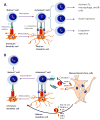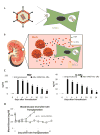Genetically modified mesenchymal stem cells for improved islet transplantation
- PMID: 21707070
- PMCID: PMC3185135
- DOI: 10.1021/mp200135e
Genetically modified mesenchymal stem cells for improved islet transplantation
Abstract
The use of adult stem cells for therapeutic purposes has met with great success in recent years. Among several types of adult stem cells, mesenchymal stem cells (MSCs) derived from bone marrow (BM) and other sources have gained popularity for basic research and clinical applications because of their therapeutic potential in treating a variety of diseases. Because of their tissue regeneration potential and immune modulation effect, MSCs were recently used as cell-based therapy to promote revascularization, increase pancreatic β-cell proliferation, and avoid allograft rejection in islet transplantation. Taking advantage of the recent progress in gene therapy, genetically modified MSCs can further enhance and expand the therapeutic benefit of primary MSCs while retaining their stem-cell-like properties. This review aims to gain a thorough understanding of the current obstacles to successful islet transplantation and discusses the potential role of primary MSCs before or after genetic modification in islet transplantation.
Figures





References
-
- Phinney DG, Kopen G, Isaacson RL, Prockop DJ. Plastic adherent stromal cells from the bone marrow of commonly used strains of inbred mice: variations in yield, growth, and differentiation. J Cell Biochem. 1999;72(4):570–85. - PubMed
-
- Kern S, Eichler H, Stoeve J, Kluter H, Bieback K. Comparative analysis of mesenchymal stem cells from bone marrow, umbilical cord blood, or adipose tissue. Stem Cells. 2006;24(5):1294–301. - PubMed
-
- Lee OK, Kuo TK, Chen WM, Lee KD, Hsieh SL, Chen TH. Isolation of multipotent mesenchymal stem cells from umbilical cord blood. Blood. 2004;103(5):1669–75. - PubMed
-
- Pittenger MF, Mackay AM, Beck SC, Jaiswal RK, Douglas R, Mosca JD, Moorman MA, Simonetti DW, Craig S, Marshak DR. Multilineage potential of adult human mesenchymal stem cells. Science. 1999;284(5411):143–7. - PubMed
-
- Zuk PA, Zhu M, Mizuno H, Huang J, Futrell JW, Katz AJ, Benhaim P, Lorenz HP, Hedrick MH. Multilineage cells from human adipose tissue: implications for cell-based therapies. Tissue Eng. 2001;7(2):211–28. - PubMed
Publication types
MeSH terms
Grants and funding
LinkOut - more resources
Full Text Sources
Medical
Miscellaneous

